Live from the emergency room, Dr Gérald Kierzek, emergency doctor and medical director of Doctissimo, explains to you how an emergency service works.
We often hear: “People come to the emergency room for nothing”. The Court of Auditors report said that 90% of people who go to the emergency room are not hospitalized. Conclusion: 90% of patients consult for nothing. This reasoning is very simplistic and does not reflect the reality of an emergency team.
Patients don’t come to the emergency room for nothing
Mainly, because you never come for nothing. If at the end of your visit to the emergency room, you come out. This means that various examinations have been carried out, that the severity of your symptoms has been assessed, and that, good news: these additional examinations are negative and therefore you can go home. But that doesn’t mean you came for nothing.
For example, out of 100 people who come to the emergency room with chest pain, the majority of patients will go home but all will have had an electrocardiogram, an x-ray of the lungs, biology (dosage of troponin)… And that’s on the Based on these examinations, doctors will be able to detect patients who have a real diagnosis of cardiovascular complications.
So out of 100 patients who come to the emergency room, 90 will actually go home but 10 will stay. And it is because the 100 will have come to the emergency room that we will have been able to save the lives of the 10 who will be hospitalized.
The key role of the orientation nurse
The organization of the emergency department is fairly standard, it is the same everywhere: you enter the emergency room, you are administratively registered and the first person you will see is a nurse or an orientation nurse. He/She will take your blood pressure, saturation and “triage” the patients according to your symptoms, their severity and the presumed diagnosis. He is really the first point of contact from the first minutes following your arrival. And after depending on the severity, the crowds and the organization, you can see a doctor.
Explanations of the continuation to the next episode.
